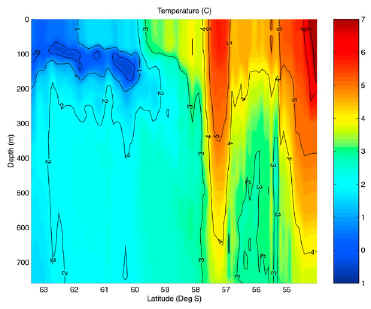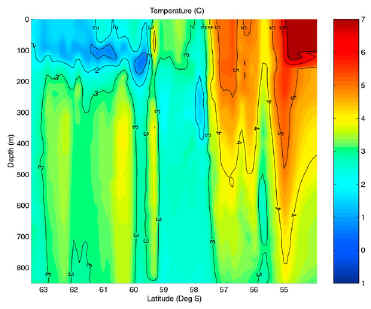
High resolution XBT/ADCP measurements across Drake Passage
 |
High resolution XBT/ADCP measurements across Drake Passage
|
Teresa Chereskin, Janet Sprintall, and Ray Peterson |
In September 1996 a high resolution expendable bathythermograph (XBT) sampling program was begun across the Drake Passage from U.S. Antarctic Supply Vessels travelling from Punta Arenas, Chile to Palmer Station, Antarctica. XBT sampling occurs on approximately six transects per year. The purpose of the sampling is to monitor seasonal, and eventually interannual, change in upper ocean temperature across the Drake Passage. In September 1999 we extended the program to include upper ocean current profiling from a hull-mounted shipboard acoustic Doppler current profiler (ADCP) that was installed during the July-August shipyard period of the ARSV Laurence M. Gould. Ocean current observations are made on every Drake Passage crossing. The purpose of the current measurements is to examine the covariability between currents and temperatures, and to determine the mean and eddy kinetic energy of the Antarctic Circumpolar Current (ACC) across the Drake Passage choke point.
The nature of the supply vessel (to ferry support personnel and scientists who conduct research in Antarctica) and the abhorrent weather within Drake Passage means that the track is not always exactly repeating (Fig. 1). However, XBT sampling usually begins at Isla de los Estados at the southeast tip of Terra del Fuego, across Drake Passage, to Anvers Island (Palmer Station), Smith Island, or King George Island. ADCP sampling begins just outside the Straits of Magellan, at longitude 68oW. The crossing of the passage itself generally takes two days. Because of the intense sampling schedule and the logistical and berthing space limitations of the vessel, the program relies on the generous assistance of Raytheon Polar Services Corporation (RPSC) personnel and cruise participants to launch the XBT probes and to supervise the ADCP. Additionally, the shipboard ADCP is monitored remotely via automated processing routines (developed by Eric Firing, Jules Hummon, and Lyn Harris) that email a subset of the data each day to scientists at Scripps Institution of Oceanography and the University of Hawaii. This facilitates some quick look analysis as well as monitoring of the system.
|
|
|
Figure 1: Principal Drake Passage XBT locations |
The ACC in Drake Passage is characterized by a series of relatively narrow eastward flowing jets, separated by broader bands of weaker flow. The main jets are associated with temperature fronts which form the boundaries between different water masses. The station spacing of the XBTs is very dense in order to resolve these fronts; the ADCP measures currents continuously. The ADCP vector velocities help to resolve the orientation of the fronts and jets, i.e. whether the fronts have been crossed at right angles. The temperature time series now consists of more than 20 sections and spans 3 annual cycles. Horizontal resolution across fronts is 6-10 km horizontal spacing with 10-15 km spacing elsewhere, and the vertical sampling extends from the surface to about 800 m depth. The ADCP time series now consists of 11 sections. The vertical sampling of the ADCP extends to about 350 m.
In April (Fig. 2) and May 2000 (Fig. 3), a warm feature was found near 57.5oS between the Polar and Subantarctic Fronts. The ADCP vector velocities suggest it is an anticyclonic eddy rather than a meander. (To tie the current features into the temperature sections, we have colored the vector velocities at 50 m depth with temperature interpolated from the XBT measurements.) This feature was observed in sections separated by 3 weeks; during that period the warm feature cooled and shifted northwards to 57oS. Eastward advection may also account for some of the observed changes.
 |
 |
| Figure 2a: XBT temperature section
|
Figure 2b: Velocity at 50 m (color is temperature)
|
 |
 |
| Figure 3a: XBT temperature section | Figure 3b: Velocity at 50 m (color is temperature) |
Sprintall, J., R. Peterson, D. Roemmich, and J. Gallo, 1997: High resolution XBT/XCTD measurements across Drake Passage. International WOCE Newsletter, 29, 18-19.